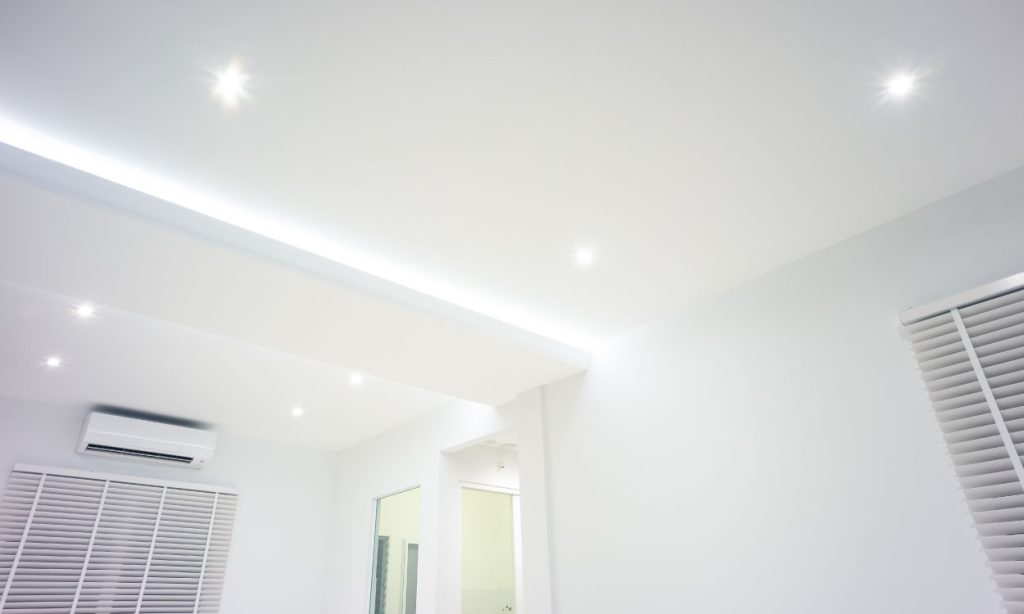What is a Drop Ceiling?

Every property is different, but one thing they often have in common is the importance of a ceiling.
While you may not have given it much thought before, your ceiling is one of the most important parts of every property and it is essential you have one that is suitable for your room.
There is a whole host of different ceiling types, and a drop ceiling is one of the most popular modern options.
In this article, we’ll explain everything you need to know about a drop ceiling, including its benefits and the different types.
Read on for more…

What is a drop ceiling?
A drop ceiling, or dropped or suspended ceiling as they are also sometimes referred to is a secondary ceiling that hangs below the main ceiling in a room. They are constructed using a metal grid that includes removable tiles and which can provide easy access to utilities.
Drop ceilings can be regularly found in a whole host of residential and commercial environments and they have a variety of purposes.
First and foremost, they are typically used to hide the building infrastructure for aesthetic reasons. This could include necessary but unsightly wiring, pipes, ductwork and more, while also allowing for repairs to be carried out in a hidden area that is not on show for you or the general public. As well as for aesthetic purposes, a drop ceiling can also help with the acoustics of a room by helping to reduce echoes and absorb sound.
The history of drop ceilings goes back hundreds of years and was first used in Japan as far back as the 1300s. Back then, they were built from planks of wood whereas these days they’re more likely to be made from metal or mental fibre.
Dropped ceilings soon spread out of Asia, and the first notable use of a drop ceiling in the UK was at the Blackfriars Theatre in London in 1596. The theatre used a drop ceiling to help with acoustics.
Modern drop ceilings that are commonplace today, largely stem from the American E.E. Hall who was granted a patent for his designs in 1923.
Different types of drop ceilings
There are two main types of drop ceilings.
These are:
- Grid ceilings
- Drywall ceilings
Let’s take a closer look at both types.
What are grid ceilings?
Grid ceilings are one of the most common types of drop ceilings and are particularly prominent in commercial spaces such as offices.
Usually, grid ceilings are made up of long strips of metal that are suspended from the main ceiling and they are arranged in a grid of squares. Then, ceiling tiles will be individually added to each grid.
There are also concealed grid ceilings which involve interlocking tiles which actually hide the grid itself.
What are drywall ceilings?
A drywall drop ceiling is unique as it does not require a frame to support it. Alternatively, sheets of drywall are hung from the main ceiling, concealing the primary one. Usually, these are preferred to grid ceilings as they are a more cost-effective option.
What are the benefits of a drop ceiling?
A drop ceiling, or suspended ceiling, offers a whole host of benefits including:
Conceals wiring and plumbing
One of the most important benefits of a drop ceiling is its ability to hide unsightly building infrastructure like electrical wiring, plumbing pipes, air ducts and ventilation systems.
In older buildings or those that have complex mechanical systems, using a drop ceiling can improve the aesthetic appearance and provide it with a clean, uniform look. This also avoids the need for extensive constriction to bury components behind walls or floors.
Easy access for repairs
Drop ceilings make it much easier to access any mechanical systems or areas that need to be repaired. You can simply lift or remove individual tiles without damaging the ceiling’s structure. This is particularly appealing in commercial spaces or large facilities where regular maintenance is required.
Furthermore, by providing quick and easy access, drop ceilings help reduce long-term maintenance costs as less labour and materials are needed to access utilities.
Enhanced acoustics
Often, drop ceiling tiles are made from materials that absorb sound, helping to reduce noise levels and echoes in a room. This is especially useful in environments where noise control is crucial, such as offices, schools and hospitals.
Acoustic tiles can help to soften echoes and reverberations which create a quieter and more pleasant atmosphere. In multi-storey buildings, drop ceilings can also help to dampen the sound coming from floors above. This improves privacy and reduces distractions in both residential and commercial settings.
Better thermal insulation
Drop ceilings can help to improve the thermal efficiency of a building by adding an extra layer of insulation between the room and the ceiling cavity. Some ceiling tiles have insulating properties that help to maintain consistent temperatures by preventing heat loss during winter and keeping space cooler during the summer.
With better temperature regulation, drop ceilings can contribute to lower energy bills as heating and cooling systems don’t have to work as hard to maintain a comfortable indoor environment. This is particularly beneficial in large commercial buildings where energy costs can be significant.
Cost-effective
When compared to drywall or other traditional ceiling options, drop ceilings are generally cheaper and quicker to install. The materials, such as grids and tiles, are relatively inexpensive and labour costs are lower because the installation is less complex.
Plus, if a tile gets damaged, it can be easily replaced at a minimal cost without having to redo the entire ceiling. This means ceilings are more affordable to maintain over time.
While drop ceilings undoubtedly provide a wide range of benefits, there are also some drawbacks you should be aware of.
For example, drop ceilings can cause a loss of space in a room by reducing the height, the area above a drop ceiling can collect dust and allergens and they may not be as sturdy as traditional ceiling types.
For more helpful and informative blogs, be sure to check out the range of articles across our website.
The post What is a Drop Ceiling? appeared first on UK Home Improvement.







